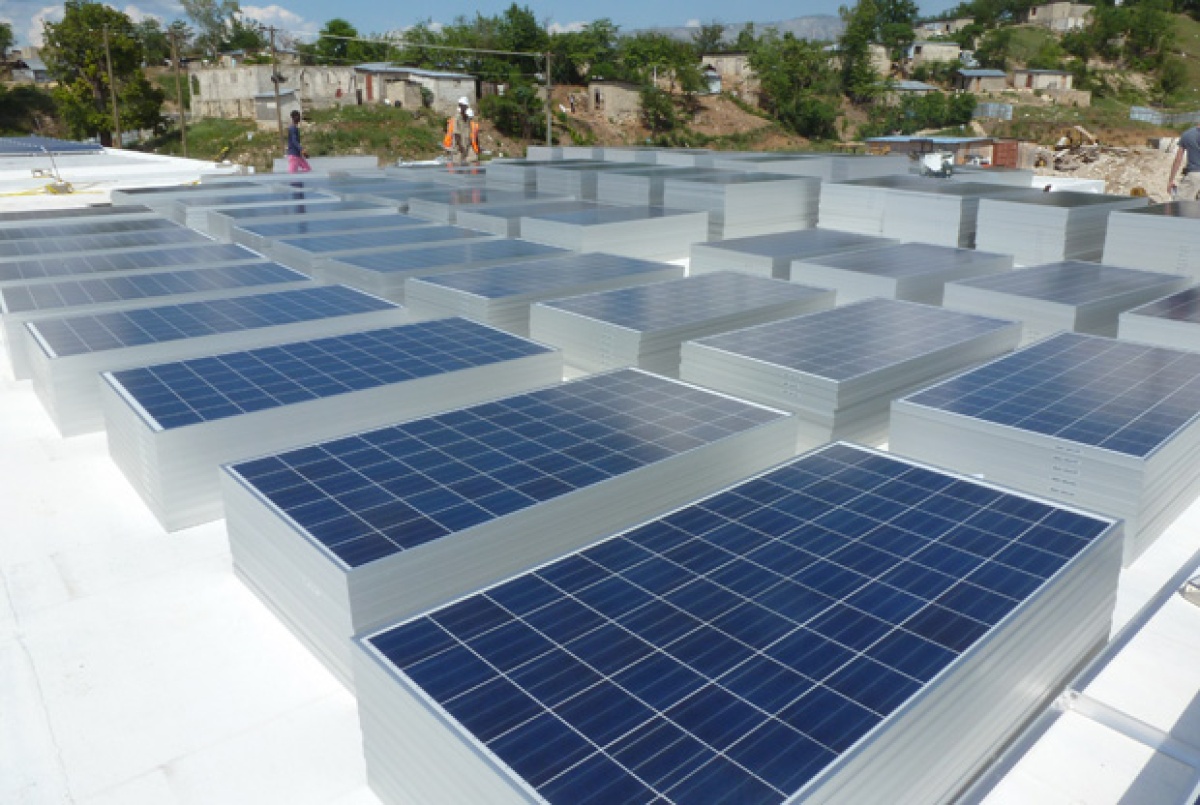Solar panels arrive at Mirebalais National Teaching Hospital
Posted on Apr 20, 2012

By Andrew Johnston
April 20, 2012
Mirebalais, HAITI -- This month, the Mirebalais Hospital construction team began a very exciting phase of the project, the installation of solar panels. With construction of the 320-bed facility nearing completion, much of the hospital roof is now being equipped with the solar panels that will provide economically and environmentally sustainable energy to the hospital.

Rows of panels being fitted on the new hospital's roof.
With 1,800 panels providing 400 kilovolt-amperes (KVA) of electricity, Mirebalais now houses the largest solar energy project in Haiti. The electricity generated will power the hospital during daylight hours and, importantly, save PIH a great deal of money on the utility bill that it can put to use for patient care. Based on current energy prices in Haiti, the panels will pay for themselves in less than three years. The use of solar energy is one of the many innovative components of the Mirebalais Hospital that, in aggregate, set the stage for providing a higher level of care and treatment to the citizens of post-earthquake Haiti.
The use of solar energy is not new to PIH. The organization uses solar energy at its 60-bed Lacolline Hospital in Haiti, Centre de St Michel in Boucan Carre, and the majority of the organization's hospitals and clinics in Lesotho and Rwanda, an achievement made possible through a longstanding partnership with Solar Electric Light Fund (SELF). These projects demonstrate that sustainable energy is not only possible in resource poor settings, but preferable.
As PIH Co-founder Paul Farmer has said, "You can't do this without electricity. Because you're not going to have an operating room. You're not going to have a laboratory. You're not going to see people at night … So it's one of two things -- either generate your own electricity with a diesel generator or go solar."

When finished, the entire roof will be outfitted with solar panels.
Part of the reason for President Clinton’s visit the Mirebalais Hospital in March was to draw attention to its use of solar energy on this project and, in doing so, the tremendous potential of solar energy in Haiti. Clinton emphasized that the Caribbean has the highest energy prices in the world, and Haiti has the highest energy prices in the region. Haiti, the poorest country in the Western Hemisphere, simply cannot afford continued dependence on expensive, non-renewable power.
With its abundant sunlight, Haiti is well positioned to benefit from recent improvements in solar technology. Clinton emphasized that increased use of solar power is fundamental to “building back better.”
I spoke with Stephen “Steve” Hopkins a solar energy expert on his recent visit to the hospital. Steve oversees renewable energy initiatives at Sullivan & McLaughlin Companies, the Boston-based electrical contracting firm that is partnering with PIH to install the solar energy system.
Andrew: What is the most important thing that you would tell people about solar energy in Haiti?
Steve: Solar is a very good choice for situations where you need to supplement the power supply. Solar works regardless of the strength of the local infrastructure. It is particularly well suited for Haiti because there is so much sunlight.
Andrew: How is the design of this project different from the projects that you normally do back home in New England?
Steve: First, we had to plan for lots more sun. The panels will generate more electricity than they would back home. Second, we planned for higher levels of heat on the roof, which can interfere with power generation and damage the panels. We compensated for the higher prevailing temperatures by mounting the panels 10 to 12 inches above the roof to allow the heat to dissipate. We also painted the roof white, which lowers the temperature of the roof and increases the amount of light on the panels. It’s quite bright up there now.
The panels are facing south and, to maximize exposure and tilted at a 10-degree angle using sun charts from the University of Oregon. It’s a much less steep angle than is required in Boston.
We are also building for long-term sustainability and reducing ongoing operating costs by building redundancy in the system in a way that is not done in the U.S. Multiple invertors and independent function between banks of panels reduce ongoing maintenance costs and ensure that if there is a problem in one area, the system as a whole will continue to generate needed electricity.
Importantly, unlike diesel generators frequently used by aid agencies, solar energy requires very little ongoing maintenance. You don’t need to do scheduled engine maintenance and filter replacements, you just need to keep out the birds so that they don’t nest in the panels. In its current design, this system can provide 25 years of trouble-free power.
---
The solar panels used in this project are manufactured by Solectria Renewables LLC of Lawrence, Massachusetts, a partner of Sullivan & McLaughlin on previous projects, and were chosen for their durability. Once the system is up and running, the public will be able to track the yield of solar power at the hospital online at: http://www.solren.com/SolrenView/index.html.
Overall, the project represents an important step forward in the use of sustainable energy in relief and reconstruction projects. Experienced aid workers are often accustomed to the noise, smoke, and expense of generator power. While solar power is cleaner and more cost-effective in the long run, restrictions by government and international donors often make it difficult for aid agencies to switch to solar power. Through its solar projects, PIH “shows what can be done,” says construction team member Jack Manderson.
Learn more about Mirebalais Hospital.

